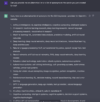This piece is part of AI on the Move, a PAN series that explores the ongoing impacts of artificial intelligence on marketing and PR.
 Generative AI continues to dominate the news cycle — from the launches of GPT-4 and Microsoft 365 Copilot to growing concerns about the technology’s safety, accuracy and ethical implications. In the first two parts of this series, PAN explored the power of collaborative intelligence and how to harness AI without sacrificing the human touch, and addressed ethical concerns surround its use, and how to stay aligned with your values and goals.
Generative AI continues to dominate the news cycle — from the launches of GPT-4 and Microsoft 365 Copilot to growing concerns about the technology’s safety, accuracy and ethical implications. In the first two parts of this series, PAN explored the power of collaborative intelligence and how to harness AI without sacrificing the human touch, and addressed ethical concerns surround its use, and how to stay aligned with your values and goals.
Marketing with ChatGPT: Do This, Not That
At this point, we’ve all seen tips for how to leverage ChatGPT in business. This is the list for practical marketers — a shortcut guide for how not to use generative AI in marketing and what to do instead, complete with actual examples and insights from our experts.
1. Campaign Optimization
Leverage ChatGPT to optimize marketing campaigns. For those still unfamiliar, generative AI searches the internet based on the user’s search request and provides a summary of relevant information. The best way to leverage ChatGPT is to ask specific follow-up questions after submitting an initial query.
For example, I asked “ChatGPT, can you give me optimization recommendations?” and its first answer was vague.

After following up through a few iterations of vague answers, I provided a more detailed query.

This chatbot is even intelligent enough to generate an A/B test.

Do This: Ask ChatGPT for Ideas
In addition to optimization suggestions, ChatGPT can create A/B testing experiments so marketers can more easily uncover valuable insights. With ChatGPT, marketers can quickly come up with multiple variations of a campaign. This helps them select the most effective version and ensure they are getting the best possible results.
Not That: Spread Misinformation
The New York Times reported that when tested, ChatGPT offered limited support for languages other than English and could not identify political material, spam, deception, or malware. This means the output the chatbot provides can be wrong. If not monitored correctly, campaigns can potentially be flagged and taken off their respective platforms for violating community guidelines.
ChatGPT also warns its users that it “may occasionally produce harmful instructions or biased content.” The knowledge base of the chatbot is limited to information up to 2021 and may unintentionally spread misinformation on current events. Even Sam Altman, CEO of parent company OpenAI, acknowledges on Twitter the chatbot’s informational limitations. ChatGPT, like many other AI bots, has its limitations and biases caused during the bot’s “training” period, which can create issues with its output. As marketers, take the chatbot’s output with a grain of salt and add in your own perspective.
2. Customer Service and Experience
Chatbots can produce responses to customer complaints and answer frequently asked questions (FAQ) by feeding it pre-existing responses via API integrations. This allows businesses to use AI language processing capabilities within their website, allowing customers to engage in a “live” conversation. As a natural language processing tool, it is able to understand customer questions and respond with relevant answers.
Here is an example of an answer ChatGPT provided as a response to a fictional customer service complaint.

Here is an example of generic FAQ suggestions provided by the chatbot.

Do This: Support Chatbots with Human Input
One of the most popular arguments for including AI in our daily lives is the amount of time it saves us on manual tasks. ChatGPT can analyze multiple interactions — like the complaint above — and summarize findings. In automating the time-consuming review process, marketers and community managers can instead use their time to strategize solutions.
Not That: Fully Automate Customer Service
If anyone has ever tried calling or chatting with customer service, then they’ve likely encountered a robot menu of general customer service prompts to choose from. There are times where chatbots are not programmed well, causing issues that could have been resolved with human intervention.
While chatbots can be of great assistance in automating responses to customer questions, it should not be the primary part of a buyer’s customer service experience. Modern-day consumers are aware of the presence of bots and the use of other AI instances throughout their purchasing journey. With 84% of people still unsure if AI in business is good or bad, companies should be diligent about how they’re adopting the use of artificial intelligence as it relates to user experiences.
3. Search Engine Optimization (SEO)
ChatGPT isn’t just for generating lists of keywords; it can also help marketers brainstorm topics by providing synonyms for terms or identifying frequently used words on a website. This information is critical for making informed decisions about which keywords to focus on in digital marketing campaigns.
In this example, I provided the chatbot its parent company’s website, OpenAI.com, and asked it to give me a list of keywords. From there, I asked for a list of alternatives or synonyms, which can help to reveal keywords competitors may not have thought of.

Do This: Optimize Keyword Research and Creative Briefs
ChatGPT can help marketers with SEO by generating ideas for content that are optimized for specific keywords and topics. After analyzing search queries and user behavior, ChatGPT can provide a list of relevant keywords to consider, which can then be used to generate ideas for blog articles or other web pages. This can be helpful for overcoming writer’s block and generating new ideas.
Not That: Replace a Professional SEO
Over 60% of B2B marketers reported that SEO and organic traffic generate more leads than any other marketing initiative (HubSpot). Understanding how crucial SEO is for marketing success, AI-powered tools can provide valuable insights and support for content and keyword research. With the rise of automated marketing, it is important to trust our SEO specialists and do our due diligence with keyword research on trusted platforms like SEMRush and Moz.
However, those tools should not be relied on solely for driving a marketing strategy. There is still ongoing research for AI possibilities and some of the pitfalls include narrowed perspectives, technical limitations, and an impersonal experience. In 2022 during a Google Search Central office-hours hangout, Google Search Advocate John Mueller commented that content created using artificial intelligence will be marked as spam, a violation of the company’s guidelines.
4. Advertising Copy and Creative Concepting
Another one of ChatGPT’s more robust and human-like features is its ability to generate content when fed a text prompt. Generative AI tools can help marketers come up with creative ideas that they may not have thought of otherwise. However, it’s important for marketers to QA the chatbot’s suggestions for market relevancy.
Below is a query where I asked ChatGPT to come up with ad copy and headline ideas.


Do This: Supporting a Robust Creative Strategy
ChatGPT acts as a springboard for ad copy ideas and the structure of a campaign so there’s no need to start from scratch every time. It can be used to write effective emails, blog teasers, or catchy titles to stand out from competition.
To get the most out of ChatGPT, it’s important to be specific. By clarifying the type of content needed along with additional direction on the target audience and the desired tone, users will see better results. It’s important to remember that as a chatbot, ChatGPT takes instructions at pure face value and often lacks creativity.
With generative AI, marketers can have more time to focus on other aspects of their work while still producing high-quality content that will engage their target audience.
Not That: Remove the Human Connection
While it’s great to use ChatGPT to help with ad copy prompts, it’s vital to keep the human as part of the equation. The most effective marketing campaigns require a deep understanding of human behavior and emotion, which can only be achieved through human intuition, empathy, and creative wit.
However, the ongoing challenge for users of ChatGPT is that it produces vague and uncreative answers which are not beneficial to a business’s marketing efforts. It is the marketer’s job to ensure the chatbot’s creative ideas meet industry standards and are relevant to a company’s efforts.
5. Lead Nurturing
Not all businesses have well established lead nurturing efforts in place. That means when leads show interest, many of them go cold because of no follow up. With the help of developers and API integration tools, chatbots can help build a lead nurturing system that will establish trust and brand loyalty. It has the capacity to remember previous user comments and provide follow-up corrections, making it easier for marketers to quickly convert leads into clients.

Do This: Supplement Sales with Automation
As mentioned before, ChatGPT’s program has an integration function. This means marketers and businesses can leverage ChatGPT’s intelligence on their own website. To use this for lead nurturing, the chatbot can ask questions to qualify leads and determine their level of interest. Or it can provide personalized product recommendations based on the information provided by the lead. With these features, ChatGPT can be used to effectively engage leads to push them closer to converting.
Even Instacart, a leading grocery delivery service, has leveraged this technology. Instacart integrated ChatGPT with its own AI and product data to allow customers to ask food-related questions and receive shoppable answers. Using this feature, customers can get inspiration by asking “easy to make lunch ideas” and purchase ingredients within the platform from their broad search query.
Not That: Leave Nurturing on Autopilot
Leaving lead nurture solely in the hands of a chatbot is bound to create problems. As humans, we crave personalized experiences. AI-generated programs won’t provide the same level of personal touch as a human representative, which can lead to a negative customer experience.
Additionally, AI-generated chatbots can misinterpret what a user is asking, resulting in irrelevant responses that can ruin the user experience. To circumvent this, feedback systems should be incorporated to improve customer service and accuracy.
How Should Businesses Approach ChatGPT in Marketing?
ChatGPT is an exciting new technology with incredible benefits and use cases for businesses. With its overnight viral success, companies are racing to integrate generative AI and launch new AI-powered solutions.. But should this tech fully replace the humans traditionally assigned to these roles? We believe that the best use of ChatGPT and AI in marketing is as a supplement, not a replacement. When marketers team up with the latest technology, businesses and employees alike can be twice as productive.
Don’t miss out on more insights related to ChatGPT in business and marketing.
Read this series:
Support, Not Replace: The Modern Marketer’s Approach to AI & ChatGPT
Ethics and Artificial Intelligence: 3 Issues with Generative AI in Business
4 Considerations for Telling Your AI Story


